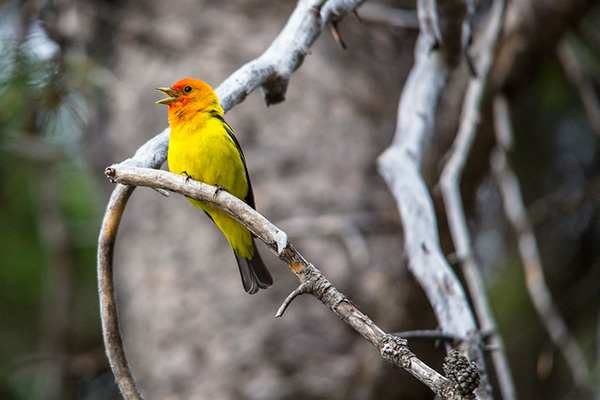Last updated: February 5, 2020
Lesson Plan
Listening to Birds

- Grade Level:
- Lower Elementary: Pre-Kindergarten through Second Grade
- Subject:
- Science
- Lesson Duration:
- 60 Minutes
- Additional Standards:
- K-ESS3-1. Use a model to represent the relationship between the needs of different plants and animals (including humans) and the places they live.
2-LS4-1. Make observations of plants and animals to compare the diversity of life in different habitats.
Essential Question
How do senses affect behavior?
Objective
Students will gain an understanding of how birds communicate.
Students will learn regional brid sounds to help identiy birds.
Background
When you hear a bird sound it is telling you what it is and where it is. Bird songs typically carry a melody and are often displays of courtship while bird calls are associated with alarm signals and communication. The songs of the birds listed below almost sound like words.
Regional Birds: Yellow warbler, Barred Owl, American Robin, Mountain Chickadee, Olive-side Flycatcher.
Preparation
- Have access to the Internet and speakers in order to access bird calls and songs and to share them with the class.
- Decide where and when you are going to walk in order to hear birds calling with the class.
Procedure
- Have students listen to birds sounds from the Audubon-Guide to North American Birds website. Note: Listen to song #1 for each bird listed below. Flathead Audubon also has local bird calls to listen to on-line. Yellow warbler, Barred Owl, American Robin, Mountain Chickadee, Olive-side Flycatcher.
- Have students learn the bird sounds that sound like words.
Sweet sweet sweet, I’m so sweet” – Yellow warbler
Who cooks for you, who cooks for you&#’;all
Sweet sweet sweet, I’m so sweet” – Yellow warbler
Who cooks for you, who cooks for you’all--Barred Owl
Cheerily, Cheer-up, cheerily--American Robin
Cheeseburger – Mountain Chickadee
Possible Extension
- Have students gather in a circle. Place one student in the middle with a blindfold.
- Students will take turns saying the blindfolded students’ name.
- Can the blind-folded student in the middle recognize who is calling their name? This is similar to when you are outside and can hear a bird but not see it. If you become familiar with the bird’s call- the tone and pattern- you will be able to “know” what bird is making that noise.
- Allow each student 2-3 guesses then rotate the person in the middle.
Vocabulary
Calls: The note or cry of a bird often indicating a warning or alarm. These are relatively simple vocalizations.
Songs: A relatively complex vocalization of a bird which can be distinguished from calls. Each species of bird has a unique song.
Assessment Materials
Go for a bird walk around the school grounds. See what birds you can hear and if the students can come up with how to mimic the birds song into words.
Related Lessons or Education Materials
Kindergarten classes can participate in an especially relevant ranger-guided Field Trip at the park focused on the five senses. To learn more, visit our Sensory Exploration Field Trip page.
